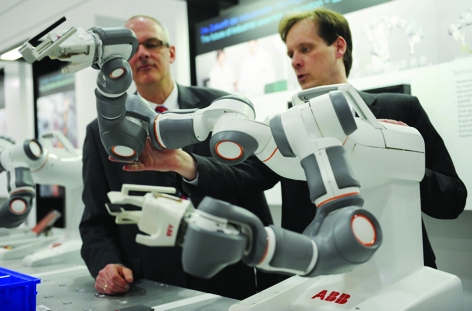As the newest member of The Engineer’s editorial team, I was faced with the rite-of-passage that is Hannover Messe – the world’s largest industrial manufacturing fair – which took place this week in Germany.
I was pre-warned that anything I might have witnessed at the ExCel or NEC would look like a mere playground in comparison; but nothing quite prepares you for the sheer dizzying, vertigo-inducing scale of the event.
With some 30 hangar-sized exhibition halls covering at total 5.3 million square feet of floor space, it felt more like a city – some sort of Disneyland of manufacturing innovation.
The stands themselves are something to behold as well – we’re talking about a whole rocket module from the Ariane launcher, frankly disturbing robot machine arms clearly plotting world domination, and rather beautiful, painstakingly cut-away engines.

Outside meanwhile there was an all electric Porsche-Ruf concept accelerating at frightening rate across the expansive pavilion (although to be fair the driver was probably just trying to get to from one end of the exhibition to the other without the half-hour walk).
I spoke with a British representative of a large German engineering firm who were returning to Hannover after a two-year, self-imposed hiatus caused by the financial crisis.
This year they wanted to announce they were ‘back with a bang’ and certainly spared no expense – my subject becoming shy as my guesses on the cost of their stand went north of a million euros.
’You would just never get anything like this back home, people just won’t spend the money. Here you get Government ministers dropping in at exhibit stands and not for cynical, opportunistic purposes as often happens back home.’
Indeed with the British Motor Show gone by the wayside is it worth asking why we don’t have something even approaching the scale of the Messe here in the UK?
Britain is of course the world’s sixth largest manufacturing nation (or seventh, depending on your league table) – yet there’s this stubbornly prevalent misconception that ‘we don’t make anything any more’.
It’s perhaps ironic that the Hannover show began in 1947 as ‘Export-Messe’ – a British-led initiative to rebuild German industry after World War II.
According to the official website ‘the victorious Western powers had decided that the only way for Germany to become economically self-reliant again would be through exporting its own goods.’
Therefore ’in order to show the world the kind of economic revival that entrepreneurs, workers and politicians were capable of jointly bringing about,’ the Germans were encouraged to organize a trade fair to promote the their goods and services.
Prescient stuff indeed. It’s tempting to speculate that a large trade fair would be an ideal way of announcing that British manufacturing ‘is back’ from the recession (although this may be jinxing the recovery given the continued skyward direction of raw material price inflation).
Plus I can’t help thinking there’s something distinctly un-British about shouting about to the roof-tops about our innovations with a hoard of dancing girls singing er … British pop songs.
But it’s worth considering given that one of the key themes of the exhibition seemed to be renewable energy, something that Britain has pretensions to be a world leader in.
There was already considerable opposition to new nuclear in Germany before Japan, so while the reactors in Fukushima are still smouldering the onus was on Hannover to display viable alternatives.
There seemed to be a recognition of the need to address the practicalities of relying on alternative energy sources, with a particular focus on intermittency. A number of researchers from the Fraunhofer Institutes are developing grid-connected fluid batteries, known as Redox flow batteries. They aim to construct a battery the size of a tennis court with a generation capability of 20 MWh to meet the power requirements of around 2000 houses during a cloudy day or a long winter night.
The researchers showcased their work by deploying a 2kW storage plant at the fair itself. A 20 kW power plant is expected to go on online next year while the researchers believe they can achieve more than 1MW of power within 5 years from a plant.




Red Bull makes hydrogen fuel cell play with AVL
Formula 1 is an anachronistic anomaly where its only cutting edge is in engine development. The rules prohibit any real innovation and there would be...